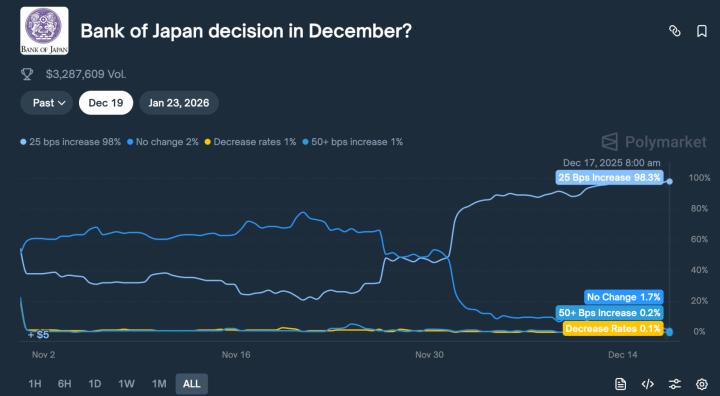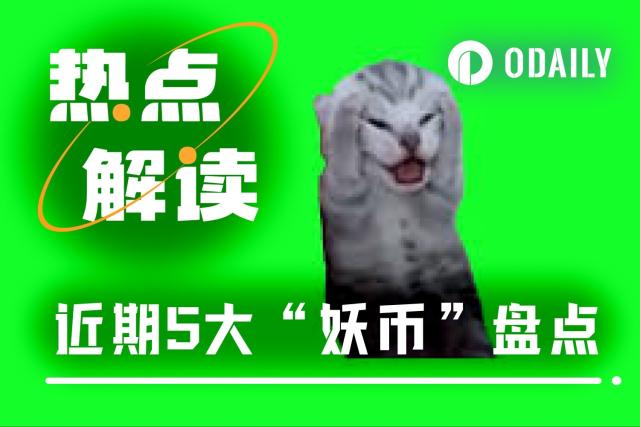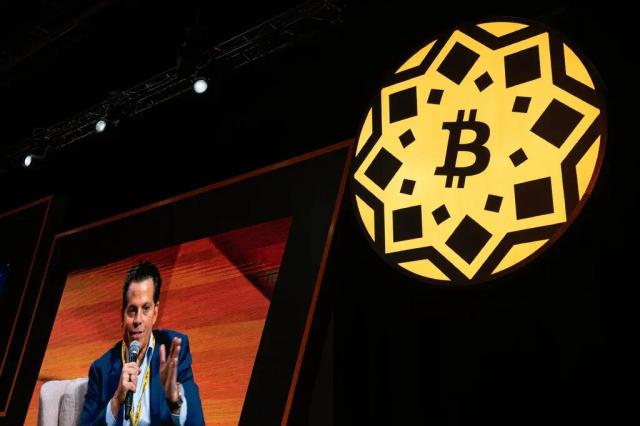Rollup has long been an important plan to scale Ethereum. By executing transactions on a separate chain and posting compressed batches of results back to Ethereum, transaction throughput is significantly cheaper and more performant than L1.
Common Rollup, such as Optimism Mainnet and Arbitrum One, enable smart contract applications to be deployed on L2 permissionlessly. However, simply publishing back to Layer1 is not a panacea for scaling. Generic L2 ends up facing:
- Congestion intensifies as apps compete for Rollup space
- There is a risk of Liquidity breakage and Cross-chain bridging between Rollup that do not share public infrastructure
- Increased overhead for developers deploying applications across multiple chains
- Efforts to keep developing and updating L2 are wasted instead of contributing to a free and open infrastructure
Additionally, smart contract applications are functionally limited to deploying the general configuration of their Rollup , and scaling the Ethereum ecosystem to nascent users will require a greater degree of developer freedom and composability.
Rollup Ecosystem Centered on Ethereum
To address these challenges, a growing narrative in Ethereum scaling revolves around a composable Rollup ecosystem with shared infrastructure. The Ethereum-centric Rollup ecosystem will benefit from a customizable execution environment, simplified Cross-chain communication, and monetization paths for application and ecosystem developers.
At least four Ethereum scaling projects have taken this approach so far, each with its own culture, value accrual mechanism, and technical design.
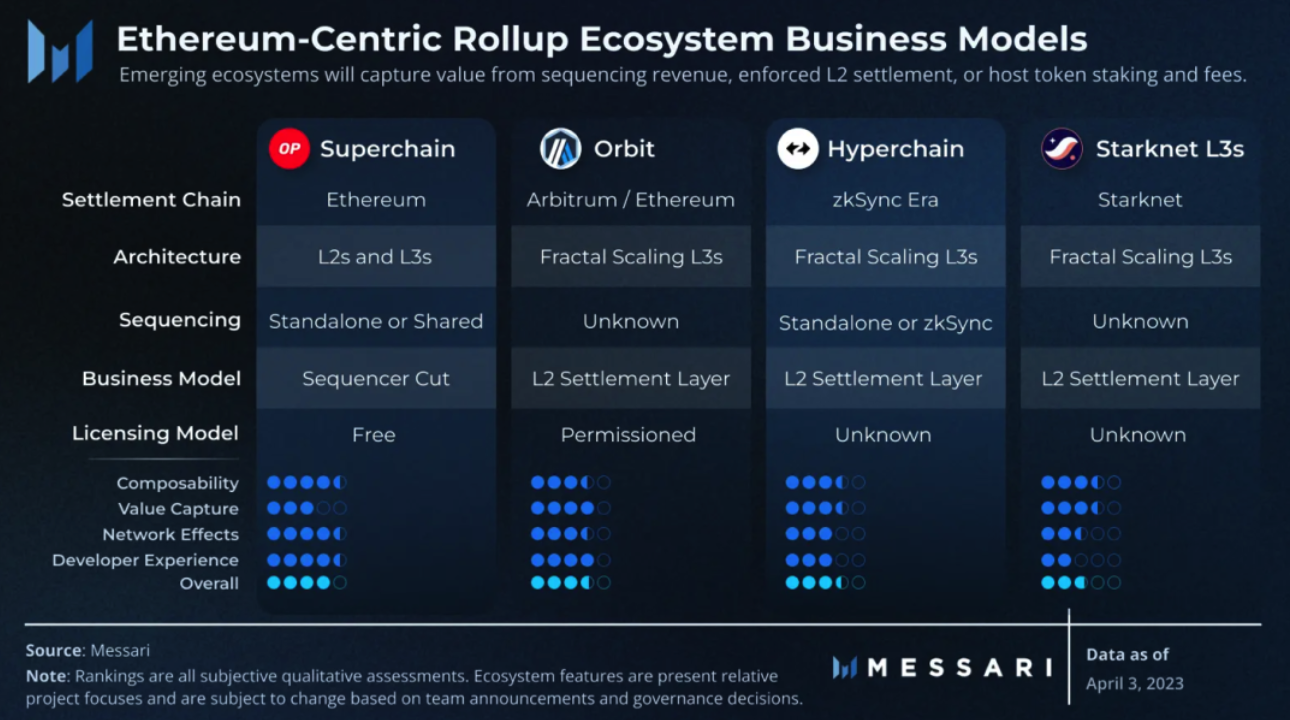 While most projects have yet to publish their full implementation details, most of them, including Arbitrum, zkSync, and Starknet, intend to extract value by using their general-purpose L2 as a settlement layer on which L3 can be deployed. Others such as Polygon may enforce Matic token staking to use the shared infrastructure of individual instances of their zkEVM.
While most projects have yet to publish their full implementation details, most of them, including Arbitrum, zkSync, and Starknet, intend to extract value by using their general-purpose L2 as a settlement layer on which L3 can be deployed. Others such as Polygon may enforce Matic token staking to use the shared infrastructure of individual instances of their zkEVM.
Optimism, on the other hand, takes an open approach on Hyperchain - avoiding restrictive commercial licenses, L2 settlement lock-ins, and enforced token staking and transaction fees. With low barriers to entry and rich public product plans, Rollup builders are incentivized to build with Optimism tools. The value attracted becomes a power-law function, with each new Rollup attracting new applications, users, and ultimately fees, a significant portion of which continues to fund the Ethereum public good.
Hyperlink Guide
Superchain is a collection of Ethereum- OP chains built using OP Stack, the software that supports the Optimism ecosystem. This includes the general-purpose Optimism Mainnet L2 and any chain that uses open-source code to build customizable modular chains. The chain built using OP Stack and managed by Optimism Collective is called "OP Chain". They can be application-specific, generic, or whatever their community wants.
At a high level, Superchain will have the following characteristics:
- Bridge on L1 to start and manage the OP chain
- Collective governance through Optimism Collective
- A market for shared ordering protocols that will provide atomic Cross-chain composability for opt-in OP chains
- Messaging layer for OP chains that do not share a sequencer set
Each function introduces new technical, social and economic primitives as part of the Superchain ecosystem, as shown in the diagram below.
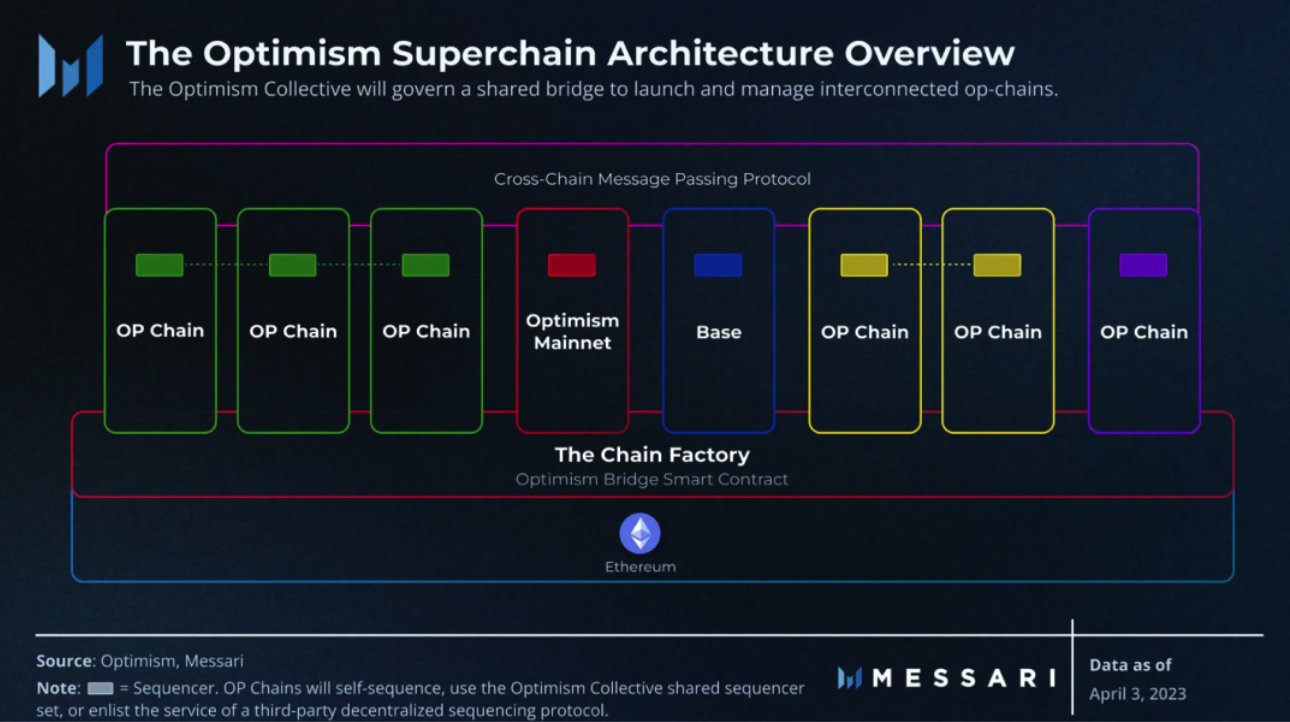 Chain Factory and Governance
Chain Factory and Governance
Every OP Chain will be connected to Chain Factory, a bridge smart contract on Ethereum L1. The bridge will be managed by the Optimism Collective. Therefore, OP Chains will share the security derived from the Ethereum consensus and the social decision-making of the Optimism community.
The bridge will contain all configuration information related to the chain (chain ID, gas limit, etc.), unlocking the following features:
- Operating nodes on any given OP chain will be able to deterministically derive the state of all OP chains in the super chain
- The contract address of the chain will be able to be calculated before deployment, allowing activities on the chain before joining the super chain. This may be useful for testing or experimenting with the execution environment before plugging it into the proof system.
The security of OP Chain is maintained by the proof system, which is a process independent of the Rollup operation, called chain derivation. Censorship resistance is preserved, as users will be able to use the bridge to bypass malicious sequencers and submit transactions directly to L1.
Sort
Hyperchain envisions an interconnected network of OP chains, some of which will share a set of orderers. The decision to self-order, utilize Optimism Collective's orderers, or enlist the services of a decentralized orderer set will be at the sole discretion of each OP chain. A market for third-party decentralized ordering protocols is expected to emerge.
Self-sequencing introduces a new revenue model where developers earn fees and MEV from the chains they publish. A decentralized orderer will serve multiple Rollup simultaneously and use cryptoeconomic incentives to hold operators accountable. A shared sequencer enables atomic and trust-minimized Cross-chain Rollup communication as nodes generate blocks on each chain simultaneously. This is a key interoperability improvement for messaging layers such as IBC that rely on asynchronous Cross-chain messaging. Other expected benefits of shared sequencers include:
- Since there is no intermediate bridge or messaging layer, the attack surface is smaller.
- When bridging, neither party has to worry about chain reorganization.
- Reduce costs by eliminating the need for Cross-chain consensus verification.
While details are yet to be determined, Optimism envisions an ordering model where third-party value capture is minimized in favor of the OP Stack's value-generating applications and public goods funding. An early model of the hyperchain ordering model involved an auction where potential orderers paid the network for ordering rights and earned their share of fees and MEV. Sequencers may also need to share some of the fee income with the Retrospective Public Goods Funding (RPGF).
Derivation: Rollup operation
OP-chains operate using chain derivation, where the canonical L2 chain is computed by orderers and validators, who inject L1 block data, L2 transaction data, and new deposits from L1. The sequencer processes transactions, builds blocks, and publishes compressed batches of blocks to L1. Validators keep track of the sequencers, and if they find invalid outputs, challenge them with fraud proofs.
Proof: Withdrawal and Bridging
The proof system is critical when withdrawing assets to L1 or bridging to other chains, as it is used to ensure that the external chain and the internal Rollup agree on the state of the asset in both systems. Superchain will eventually use the Cannon fraud proof engine to handle L1 withdrawal disputes. Additionally, due to its modular design, Hyperchain will be able to support multiple redundant proof implementations simultaneously. This includes proof of implementation validity if required by the Optimism community.
As mentioned earlier, OP chains can synchronize each other's state through the chain factory. This becomes the basis for L2-to-L2 bridging of OP chains that do not share a sequencer set. Each OP chain will determine the security guarantees they are willing to make using this shared messaging layer. For some, the derivation process may suffice, but similar to L1 withdrawals, ensuring the validity of this L2-to-L2 bridge will require a proof system to verify the state of each OP chain at the time of transfer. The latter represents an opportunity for proof-based bridging and decentralized ordering protocols to diversify their offerings by securing cross-hyperchain transactions.
Super chain progress
The initial version of Superchain is expected to launch sometime in 2023. In February, Coinbase announced its intention to launch a second OP chain, Base, after the Optimism Mainnet upgrade to OP Stack in the coming weeks. Coinbase joined OP Labs as a core developer of the OP Stack, and together they first tackled the ordering and shared messaging layers. The two parties intend to launch an Alpha fraud proof engine and validator set by the end of the year.
progressive decentralization
In the process, Superchain will have various components decentralized. That is, the upgradeability of the chain factory, the realization of decentralized sorting, and the realization of the proof system.
Hyperchains will always require some form of decentralized governance. This will initially include a Chain Factory Upgradability Security Committee, but in the future the Optimism Mainnet may take on a new role of coordinating and managing the Hyperchain.
As for the proof system, the Alpha release will include a set of permissioned signers proving invalid state roots in case of dispute. They will act as a last line of defense, verifying that withdrawal statements do not contain invalid outputs before Cannon's fraud proof engine becomes available.
future adjustment
OP Stack initially provides security defaults that OP Chains must follow in order to be part of the Hyperchain. Chains that replace standard modules with experimental modules are considered "hacks". However, in the future, Superchains may contain hacked chains as determined by Optimism governance. These may include:
- Exchange Execution Layer
- Swap out the data availability layer
- Using Multiple Proof Systems Simultaneously
While not at the protocol level, another interesting development is auto-scalable smart contracts to offset OP Chain state bloat. In Hyperchain, “chains start to be treated as commodities — interchangeable computing resources become possible.” Application users can migrate from one OP chain to another without breaking existing logic.
competition analysis
Optimism was one of the first projects to address the composable ethereum Rollup ecosystem, and a number of L2 competitors have announced their own projects in recent months. While each project has a different design, value capture mechanism, and culture, the proliferation of the Rollup ecosystem is the key narrative and infrastructure unlock for future application development on Ethereum.
Composable Multichain ecosystems are only now appearing in the Ethereum ecosystem, but when you narrow it down, the idea is not new. At a high level, they can be broken down into three different models:
- Lisk (with shared security)
- Fractal expansion
- L2 Rollup Ecosystem
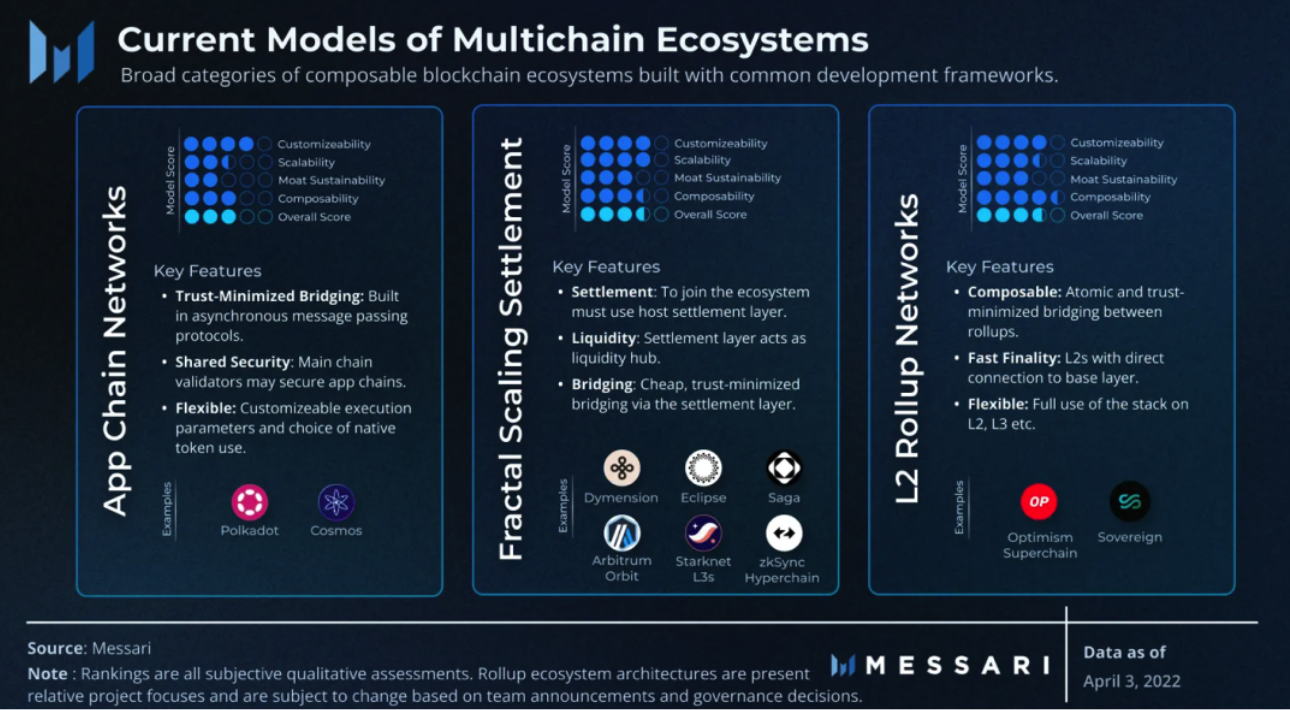 Application Chain Ecosystem
Application Chain Ecosystem
Ethereum’s early successors, Cosmos and Polkadot, set out to alleviate network congestion and lead to the emergence of interoperable application chains, each with its own community and use cases. Lisk is built using common development frameworks (Cosmos SDK and Substrate) and trust-minimized messaging protocols (IBC and XCM).
- Polkadot: Polkadot can be said to be a pioneer in scaling. It is one of the first examples of a network that separates execution from consensus and data availability, and features shared security by its main chain validators. Users of these chains do not pay fees to Polkadot main chain validators, nor are they required to use DOT as a fee token. Polkadot captures value from developers, as parachains require DOT to be bonded nearly two years in advance, while parathreads operate on a pay-as-you-go basis. Most Polkadot-based chains crowdfund DOT from their community in order to have enough connections to join the ecosystem. Moonbeam was the winner of the first parachain auction in late 2021, procuring over $210 million in DOT at today's prices. Crowdfunding such a large amount of money is a heavy burden on the community until product market fit has been proven.
- Cosmos: Until recently, all chains in the Cosmos ecosystem were required to bootstrap their own validator set. But last month, the Cosmos Hub adopted Replicated Security, and the "consumer chain" can choose to use the Cosmos Hub validator set. The Cosmos Hub extracts value through a custom allocation of transaction fees and token inflation. Consumer chains can choose ATOM, native token, or any other tokens (such as Stablecoin) as transaction fees.
While Polkadot and Cosmos have shared security and trust-minimized bridges, both are currently limited to about 100 chains that can join their ecosystems. Furthermore, neither network benefits from the atomic Cross-chain composability supported by a shared set of orderers. Chains in these ecosystems must run full nodes (Polkadot) or light nodes (Cosmos) of other chains in their respective networks to verify the state of incoming blocks and process Cross-chain transactions. These messaging layers are asynchronous. Meaning, there is a delay of at least two blocks when sending tokens between chains. This delay makes financial transactions, especially those with low-latency requirements such as Flash Loan, less than ideal in the Lisk network.
Fractal Expansion Ecosystem
Fractal scaling refers to projects that focus on Rollup on the L3 interconnection network using the L2 settlement layer. However, this does not preclude these projects from eventually providing permissionless Rollup on L2. Doing so will ultimately depend on the project's licensing model.
Before diving into this type of Rollup ecosystem, a quick recap of the main frameworks used to build Rollup :
- Centered on Ethereum: Rollup SDK is used to build "smart contract"Rollup and settle to the Ethereum-based chain (Ethereum L1 or L2, etc.).
- Cosmos-centric: "sovereignty" or "settlement"Rollup are built using a modified version of the Cosmos SDK. Most of these chains use Celestia-based Rollup and benefit from messaging via IBC.
However, the Rollup framework does not have strict and fast rules. The ultimate goal of most Rollup SDKs is a customizable, chain-agnostic solution.
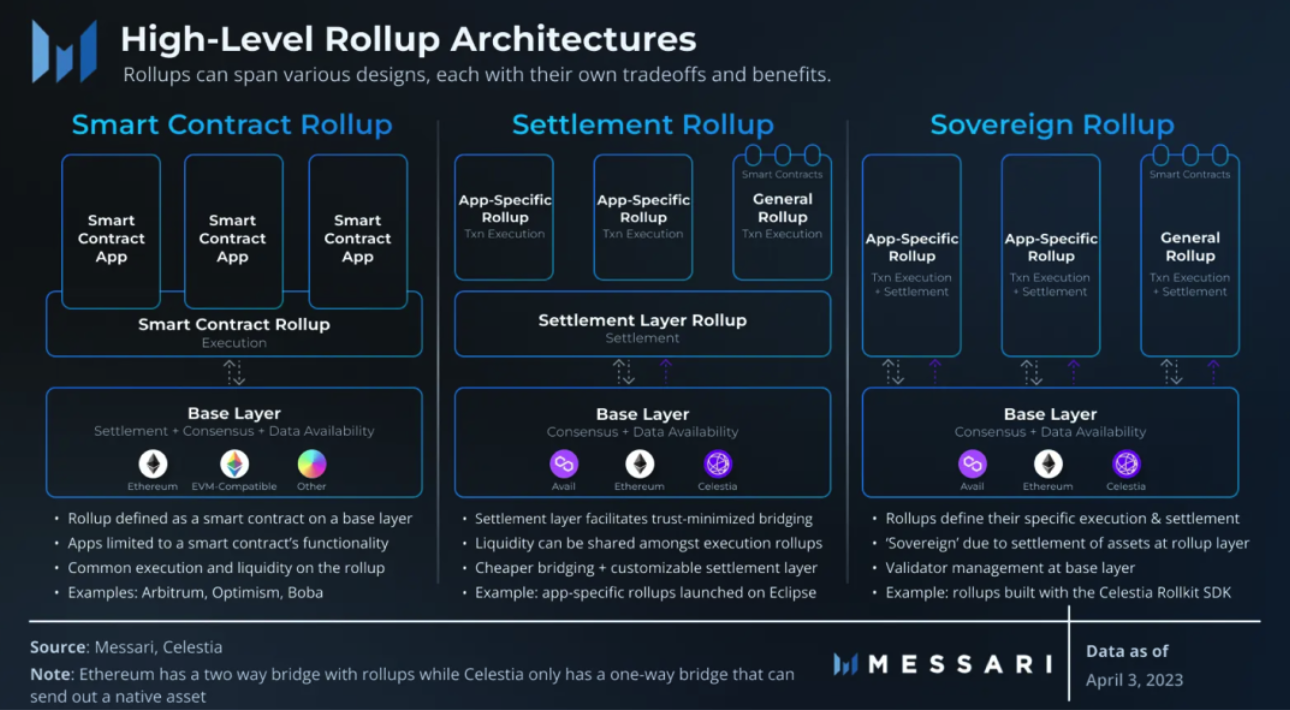 For the purposes of this analysis, an Ethereum-centric Rollup that settles to L2 and a Cosmos-centric Rollup on Celestia are considered to have the same basic business model. Both extract value by enforcing the use of intermediate or settlement layers to bring value to their respective protocols through bridging and batch submission fees.
For the purposes of this analysis, an Ethereum-centric Rollup that settles to L2 and a Cosmos-centric Rollup on Celestia are considered to have the same basic business model. Both extract value by enforcing the use of intermediate or settlement layers to bring value to their respective protocols through bridging and batch submission fees.
Projects that provide Rollup settlement layers act as a service that relieves developers of the need to plug in underlying consensus and data availability layers. The value proposition of the Cosmos-centric Rollup settlement layer includes:
- As a shared Liquidity center, Celestia L1 does not manage tokens.
- In addition to IBC's default trust-minimized bridge, a shared orderer service (an additional revenue source) is provided.
- Many, such as Eclipse and Saga, offer no-code rollup deployment services to further simplify the build process.
On the other hand, the main appeal of the emerging settlement layers offered on Ethereum (such as Arbitrum Orbit, Starknet L3s, and zkSync Hyperchain) is the cheaper inter- Rollup bridge compared to a standalone Rollup connected to Ethereum L1. This is because existing Ethereum-based Rollup(which do not share the set of orderers) must bridge down one layer before bridging to another chain. For end users, going from L3 > L2 > L3 must be cheaper than L2 > L1 > L2.
Arbitrum Orbit (and then Starknet and zkSync Hyperchain) will capture value by forcing a steady stream of builders who pay the protocol to settle on its chain. Anyone is free to customize and launch rollups using the Nitro rollup SDK, as long as they rely on the general Arbitrum chains (One and Nova) for settlement. This translates into revenue from Rollup developers to the Arbitrum collator (currently operated by OffChain Labs, but subject to change at the DAO's discretion). Rollup built with Nitro will also be able to launch as their own L2 on Ethereum L1, but this requires explicit DAO permission. Arbitrum is effectively treating the use of its code base as a service where its community controls who they get value from.
The Ethereum-centric settlement layer has yet to confirm a shared ordering model to capture value from its ecosystem. This may involve decentralized orderings secured by respective tokens, or may be abstracted to third-party protocols, which is an added expense for developers to consider enhancing L3 composability.
L2 Rollup Ecosystem
While L1 settlement is certainly possible for rollups built on Ethereum, whether the rollups' ecosystem does so ultimately depends on the project's permissioning model. So far, Hyperchain has been on its own path, providing L1 settlement for the Rollup ecosystem centered on Ethereum. Sovereign Labs and Polygon also appear to be creating L2 Rollup ecosystems, but the details of their implementation are thus far from clear.
- Sovereign: Sovereign Labs is building the Sovereign SDK; a Cosmos-centric Rollup SDK specifically for ZK-rollups. Chains built using the Sovereign SDK are designed to be natively interoperable and will adapt to any existing L1. It's unclear how the protocol intends to extract value from the ecosystem it's developing in, but the Sovereign codebase currently uses the Apache 2.0 license, meaning anyone is free to use or modify its code.
- Polygon zkEVM: The Polygon zkEVM model appears to require some form of Matic token staking and transaction fees in order to join its Rollup ecosystem that settles to Ethereum L1. Since rollups do not solve the consensus problem by definition, traditional PoS validator staking is not required. This means that Matic staking will be used for some other purpose, such as a Rollup sorter or a binding mechanism for a set of sorters. If so, this will lock users and developers from using Polygon 's tokens for chains in its zkEVM ecosystem.
Where the super chain comes in handy
Hyperchain exists in a market with a variety of emerging competitors and methods of extracting value. Hyperchain is different in that it captures value not from individual users or developers, but from service providers in exchange for the right to participate in its ecosystem. This revenue will be used to support the public goods of the network. Superchain's opt-in ordering model will likely involve an auction, where potential orderers will be required to pay for ordering rights and earn their share of the fees. The sequencer may also need to share a portion of the fee income with the RPGF.
Rollups will be able to deploy permissionlessly to L1, L2 or wherever they like using the OP Stack. By adding to Ethereum, OP Stack benefits from battle-tested code and existing user and developer base. Thus, the OP Stack can both increase the growth rate of builders and broaden the range of designs they build.
To opt-in to the hyperchain is to opt-in to the collective governance of the chain factory and use bridging L1 and access to trust-minimized Cross-chain messaging. A potential downside of this model is that the decision to upgrade the bridge rests in the hands of the wider OP community. This is likely to be a key driver of participation in governance and thus usage of OP tokens, and fits into the collective modus operandi of Optimism. However, OP chains that disagree with approved governance decisions will be required to leave or swallow changes to the Rollup ecosystem. Not all developers are willing to sacrifice this level of sovereignty over their chains.
The hyperchain policy is by far the most permissive in the highly competitive Rollup ecosystem. This, combined with the availability of the OP Stack, led to early success, as Optimism's code base was the most forked of any L2. Before the launch of Superchain, the pattern of OP Stack was already expanding. It will likely grow even more as the no-code platform Conduit develops to launch and manage the OP Chain.
Ease of development combined with an opt-in shared ordering model means low barriers to entry and high degrees of freedom for protocol developers to build businesses in the Hyperchain. Furthermore, the results of RPGF are expected to enhance the already free toolkit to motivate future optimizations.
Summarize
The Optimism community is embarking on a multi-year journey to build Hyperchain, an interconnected Rollup ecosystem centered on Ethereum. The value proposition of Superchain is the sustainable expansion of Ethereum, combined with common infrastructure and community-based decision-making. Hyperchain aims to deliver maximum value to opt-in developers, not to find ways to extract value. With RPGF from sequencing revenue, this should lead to a proliferation of composable new applications and business models. For end users, this looks like a cost-effective computing platform for financial use cases and other similar applications. In the world of probability, the larger the range of possibilities, the better, and the super chain may provide broad opportunities and potential.




